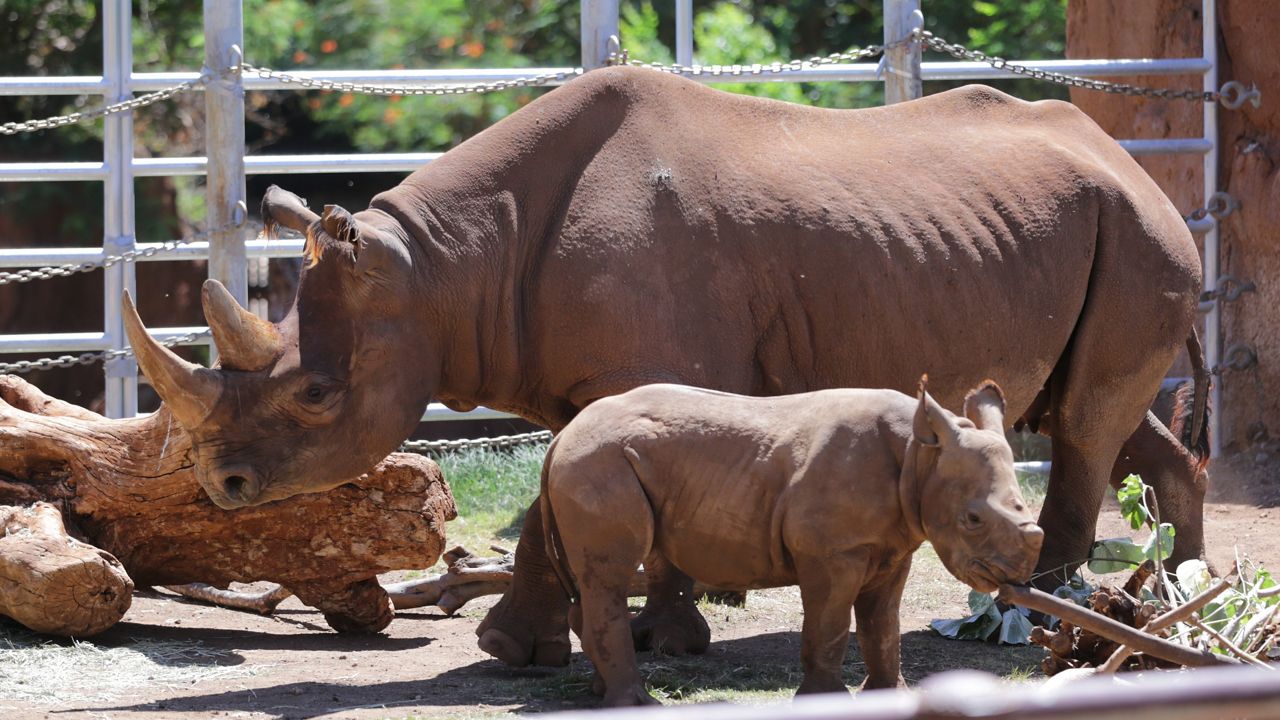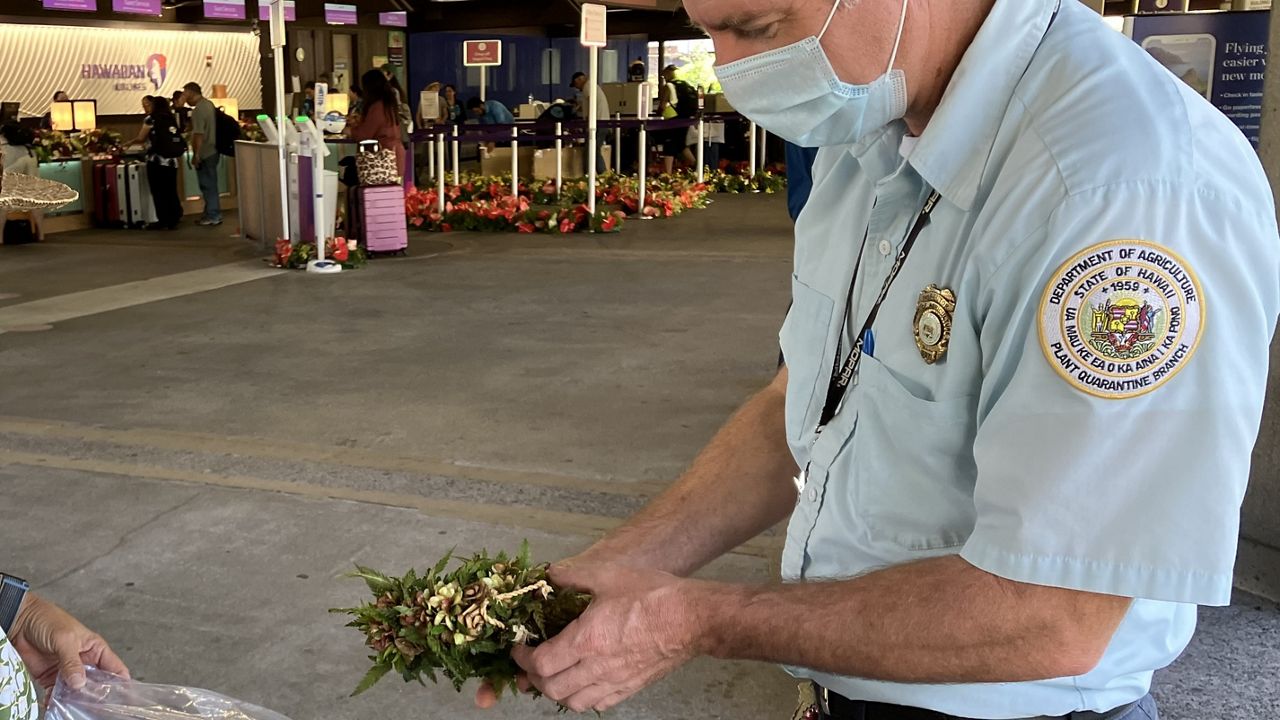All year long, Spectrum News Hawaii has been covering what is happening at the Honolulu Zoo. Here is a look back at some of the biggest stories.
1. Baby rhino is a first for Honolulu Zoo
Mama Aria and papa Kendi became the proud parents of a male baby Eastern black rhinoceros born on April 19 at the Honolulu Zoo.
Both parents arrived at the zoo in September and November of last year from San Diego, and are a breeding pair as part of the Association of Zoos and Aquariums Species Survival Plan.
“We are all so thrilled with the very first birth of a rhinoceros at the Honolulu Zoo,” said Honolulu Zoo Director Linda Santos.
The baby rhino was named Akamu.
If you would like to learn more about the three black rhinos at the Honolulu Zoo, read this special report on what it’s like to be a rhino zoo keeper.
2. The Honolulu Zoo welcomes an 8-year-old lion named Enzi
In May, The Honolulu Zoo welcomed a male lion named Enzi, who was born on Sept. 21, 2015, in Indianapolis.
Zookeepers introduced Enzi into the lion habitat where a 14-year-old lioness Moxy lives.
Moxy is past her breeding age; it was never planned for the two to mate.
“We are very fortunate that the Association of Zoos and Aquariums was able to identify a male lion for the Honolulu Zoo and we are all very excited to welcome him to his new home in the African Savanna,” said Honolulu Zoo Director Linda Santos.
3. City raises Honolulu Zoo admission by $2
This summer, the City approved a $2 price hike to get into the Honolulu Zoo.
The price increase means that admission for Hawaii residents and military members over the age of 13 is now $10, while for children between 3 to 12 it is $6. For non-residents, admission for those over the age of 13 is $21, and for children ages 3-12 it is $13. Children under the age of 2 still receive free admission, along with Honolulu Zoological Society members.
The last time the Honolulu Zoo increased its fee for Hawaii residents was in 2011. The fee for non-residents was increased in 2017.
The City and County of Honolulu provides more than $2 million annually to subsidize the zoo’s total operation costs. The zoo’s annual budget is $7,347,489.
Council member Calvin Say said during a Honolulu City Council meeting on May 2 that the city’s funds come in part from real property taxes.
The city’s costs are offset by the zoo’s price of admission, so if more people visit the zoo and if the cost of admission is higher, then the City will be required to contribute less.
To learn more about the Honolulu Zoo’s plans for the future, read this feature on the ambitions of Honolulu Zoo Director Linda Santos.
Harriet, the Honolulu Zoo’s female Linnaeus’ two-toed sloth, died on Oct. 26 due to the progression of kidney disease.
Honolulu Zoo Director Linda Santos stated that veterinary, curator and keeper staff decided to euthanize Harriet after several months of intensive treatment for her kidney disease.
“Harriet was a lovable sloth and a very good mother,” Santos said. “She allowed staff to work with her and her offspring and enjoyed being hand-fed healthy treats, including her favorite mountain apple grown on zoo grounds. The zoo staff, visitors and viewers of the live sloth cam will all miss her dearly.”
Harriet arrived at the Honolulu Zoo in December 2013. She was introduced to her new mate, Quando, in February 2014. Harriet and Quando became a valuable breeding pair as part of the Association of Zoos and Aquariums' Species Survival Plan. The duo produced seven offspring at the Honolulu Zoo — six females and one male.
Harriet’s exact age is unknown; however, based on her breeding history (she had previously given birth before arriving at the zoo), she was over 14.
5. Honolulu Zoo euthanizes two Sumatran tigers
The Honolulu Zoo euthanized two of its three Sumatran tigers in January due to worsening kidney disease in both animals.
Fifteen-year-old Seattle was euthanized under anesthesia on Jan. 5 after falling ill with Bartonella infection the previous month. The infection exacerbated Seattle’s previously diagnosed kidney disease, which resulted in acute renal failure.
Seattle was born at the Los Angeles Zoo in 2007 and lived at the Baton Rouge Zoo in Louisiana until being transferred to Honolulu in June in hopes he would breed with the Honolulu Zoo’s female tiger Anala.
Chrissie, one of the oldest Sumatran tigers in captivity at 23, had been treated for kidney disease for more than 12 years but recently experienced a loss of appetite and activity.
Chrissie was born in 1999 at the Smithsonian’s National Zoo. While at the Honolulu Zoo in 2008, she gave birth to three cubs, who were transferred to other zoos.
6. Honolulu Zoo’s Sumatran tiger undergoes artificial insemination
In October, 6-year-old Anala, Honolulu Zoo’s resident Sumatran tiger, underwent a “novel artificial insemination procedure” with the help of a team of reproductive specialists from Omaha’s Henry Doorly Zoo.
The novel procedure, laparoscopic oviductal artificial insemination, has only been performed in a handful of tigers, according to the Honolulu Zoo. This procedure allows the sperm to be directly deposited into the female’s oviducts next to where her eggs should ovulate. Because of this, the number of spermatozoa needed is much less — only one million compared to over 100 million needed for a non-surgical transcervical approach.
Cryopreserved spermatozoa were collected from a male Sumatran tiger at another Association of Zoos & Aquariums-accredited zoo.
AI has led to successful births in other species, such as domestic cats, wolves, rhinos, oryx, clouded leopards, and the Tsushima leopard cat. However, so far, AI has led to just four pregnancies in tigers with an “overall pregnancy rate of less than 20% and no live births.”
Because of the limited numbers of Sumatran tigers remaining in captivity, the Sumatran Tiger Species Survival Plan continues its efforts to achieve conception and live birth through AI matchmaking, as well as the ongoing physical relocation of suitable matches for reproduction.
If Anala doesn’t become pregnant through the AI procedure, the Honolulu Zoo will welcome a male tiger as a potential mate in 2024.
If you would like to learn more about the Honolulu Zoo’s breeding programs, read a feature about how the zoo breeds hundreds of Kamehameha butterflies.
7. Procedure is a success for Honolulu Zoo's geriatric giraffe
Adult giraffes are one of the most challenging animals to anesthetize because of their enormous size and unique body shape. This is why zoo staff flew in giraffe specialists to help immobilize 23-year-old Squirt, the 19-foot tall, 2,000-pound resident male Reticulated giraffe, to perform treatment for chronic hoof and limb issues.
The May 2 procedure required the expertise of giraffe veterinary specialist Dr. Liza Dadone and farrier Steve Foxworth of the Zoo Hoofstock Trim Program. The two professionals assisted with the planning and execution of the procedure, from immobilizing Squirt to anesthetizing him and addressing his issues.
According to the zoo, hoof overgrowth and arthritis are common in older giraffes kept in captivity. Treatment can include hoof trimming, supportive shoes, nutritional supplements, substrate modification and pain relief medication.
Over 45 individuals from the zoo and medical community worked with the staff veterinary and animal care teams, providing care and conducting multiple treatments while Squirt was under anesthesia. The goal was to minimize, as much as possible, the greatest risks to Squirt and provide the best opportunity for recovery.
Individuals from the zoo and medical community worked with the staff veterinary and animal care teams to conduct a successful procedure.
Multiple treatments included hoof trimming of all four feet, pulsed electromagnetic field therapy, placement of a custom urethane shoe, ultrasound examination of the limb soft tissue support structures, blood sampling, radiographs and a bath to treat chronic skin lesions.
In addition, more than one billion giraffe stem cells were flown in and administered by Dr. Valerie Johnson, a veterinary specialist in immunotherapy and regenerative medicine from Michigan State University.
Upon completion of the procedure, Squirt stood up on his own and began eating.
“After this immobilization, we have noticed him immediately placing more weight on his newly shod foot and taking longer, more comfortable strides,” said Honolulu Zoo veterinarian Dr. Jill Yoshicedo.
Michelle Broder Van Dyke covers the Hawaiian Islands for Spectrum News Hawaii. Email her at michelle.brodervandyke@charter.com.









